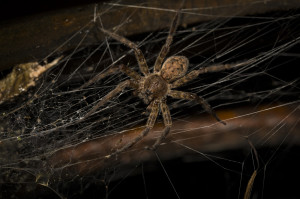While the most dangerous spider in our Sacramento pest control region is the Black Widow, several other common spiders are prone to invade our homes, particularly as the summer weather heats up. Most household spiders don’t have mouth parts large enough to bite. One exception is the wolf spider, and even though its bite is not venomous, it can still pose a danger, particularly to small pets and children.
 Wolf spiders get their name because of their hairy bodies and because they go out and hunt for their food like a real wolf. Most of the time, wolf spiders are found outdoors, in the garden, under rocks or climbing trees and fences in search of prey. They spin a small web, not to catch prey as many spiders do, but to relax after a hard day’s night, or day, of hunting. They eat a lot of common insects found in and around our Sacramento gardens. But they also venture inside homes, because who doesn’t like a climate controlled environment?
Wolf spiders get their name because of their hairy bodies and because they go out and hunt for their food like a real wolf. Most of the time, wolf spiders are found outdoors, in the garden, under rocks or climbing trees and fences in search of prey. They spin a small web, not to catch prey as many spiders do, but to relax after a hard day’s night, or day, of hunting. They eat a lot of common insects found in and around our Sacramento gardens. But they also venture inside homes, because who doesn’t like a climate controlled environment?
There are about 200 different species of wolf spiders. The vast majority are between one-half and one inch in length. Often their colored, fur-like appearance closely resembles their natural environment of browns and greens, and they usually have strong dark and light contrasting colors. Wolf spiders have excellent eyesight for hunting their prey. Their bite, while it may be painful, is not known to pose any health risk.
The female wolf spider carries her hatched brood of spiderlings with her. A mother wolf spider with a dozen or more kids hitch-hiking on her back may look much larger than she is. She feeds the crew for a couple of days after birth, until they are large enough to hop off her back and go search for their own food. It’s usually after the teenage spiders start exploring on their own, possibly inside your house, that the wolf spider population becomes a nuisance. Generally, regular pest control services to treat the perimeter of your home will keep wolf spiders outside in the garden—where they can feast on all the bugs that eat our flowers, fruits, and vegetables rather than moving in with us and our families.


